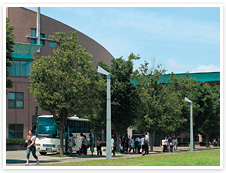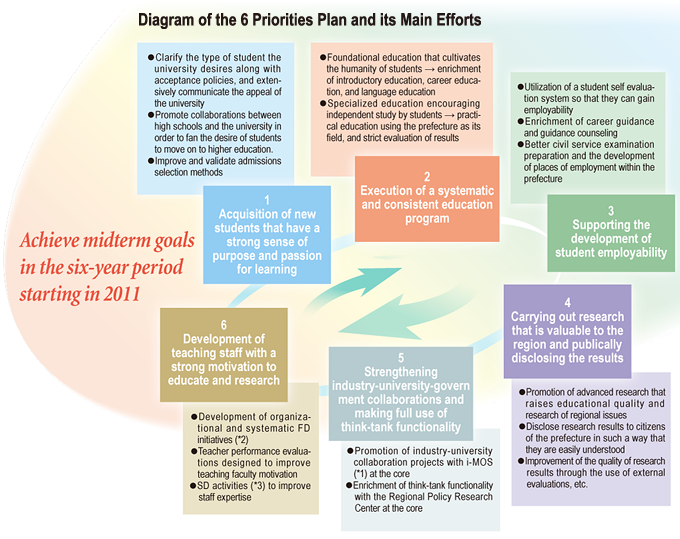- Striving to Become a University that Contributes to Core Human Resource Development and the Generation of Vitality in the Local Community
- Second Phase Midterm Goals
- The “6 Priorities Plan” and “University-wide Common Plan” of the Second Phase Midterm Plan
- Priority Efforts in the 2011 Plan
- Featured Topic Support for Students Affected by the Great East Japan Earthquake and Tsunami
 In 2011, we reach the second phase midterm goal period since the prefectural university became a public university corporation. From 2011 to 2016, Iwate Prefectural University will be operated following a “Midterm Plan” based upon the midterm goals for that six-year period, and in accordance with an annual plan each year.
In 2011, we reach the second phase midterm goal period since the prefectural university became a public university corporation. From 2011 to 2016, Iwate Prefectural University will be operated following a “Midterm Plan” based upon the midterm goals for that six-year period, and in accordance with an annual plan each year.
The university's mid-term goal is to contribute to the development of core human resources and vitalization in the local community from two basic perspectives: the perspective of the students, providing a "student-driven education," and the perspective of the local community, making "research and local contribution efforts that vitalize Iwate."
The university has set three basic goals: to be a university that strengthens the “will” of students when it comes to education, a university relied upon by the local community when it comes to research, regional contribution and international exchange, and to be “agile and efficient” when it comes to university business operations. The university is tackling education, research, and regional contributions while keeping a steady eye on the various environmental changes surrounding the university, all the while re-recognizing the mission of the university that was established when it was first opened.
A university that contributes to core human resource development and the generation of vitality in the region
<Basic Stance>
● Education that puts students first
● Research and regional contributions that generate vitality in Iwate
The Midterm Plan, which is intended to achieve the second phase midterm goals, is composed of a “6 Priorities Plan” for issues that have especially high urgency, importance, and continuity, and a “University-wide Common Plan” that will be taken up by the entire university in order to deploy the priorities plan.

1. Acquisition of new students that have a strong sense of purpose and passion for learning
- Clarification of the admission policies of each department, etc.
- Understand past admissions results and the needs of high schools, and determine issues in the current admissions system
- Establishment of policies for undertaking new high school-university collaborations
2. Execution of a systematic and consistent education program
- Examine the state of foundational education as we move toward the planned opening in 2013 of the Center for Higher Education Planning (provisional name)
- Clarification of the degree conferment policy (diploma policy) of each department, etc.
- Examine the state of student independent study and practical education
- Sort out issues as we move towards the introduction of the GPA system (*4) and establish introduction procedures, etc.
3. Supporting the development of student employability
- Promote the introduction of IPU-E map (*5) into the university
- Full-scale launch of the IPU-E project (*6)
- Promote exchange with businesses in the prefecture in order to create new jobs, and urge institutions offering apprenticeships to increase employment and hire early
4. Carrying out research that is valuable to the region and publically disclosing the results
- Improve the scientific research grant application rate by prioritizing research of regional issues and research that promotes specialized department education
- Make public disclosure of research results obligatory as allocation criteria for academic research funds, and increase opportunities to provide information to citizens of the prefecture
5. Strengthening industry-university-government collaborations and making full use of think-tank functionality
- Establishment of i-MOS and promotion of joint research and high-level engineer development
- Establishment of Regional Policy Research Center and preparation as a think-tank
6. Development of teaching staff with a strong motivation to educate and research
- Improvement of FD implementation system and implementation method in order to resolve educational issues
- Preparation of a unique university training system in order to improve the abilities of office staff
Featured Topic Support for Students Affected by the Great East Japan Earthquake and Tsunami
In addition to the 2011 Plan described on this page, Iwate Prefectural University is also actively engaged in thorough student support so that both existing students and new students affected by the Tohoku earthquake and tsunami can study with peace of mind.
Concerning students that have suffered great hardships, economic support such as exemption from enrollment and course fees, assistance through scholarships, and so on are being provided. (This is currently to continue until the first term of 2012.)
Furthermore, "special disaster selection" is being implemented, targeting high school students within the prefecture who were victims of the disaster. Special measures are even in place so that affected students of other universities can be accepted as credited auditors.
As a university in a disaster-stricken prefecture, we are working together with the citizens of the prefecture such that they can secure opportunities for higher education, and so that we can contribute to the reconstruction of Iwate over a long period of time.
Notes
- *1: Iwate Monodukuri and Software Integration Technology Center
- *2: Efforts to improve class content and methods. Faculty Development.
- *3: Efforts to improve the abilities of office staff, etc. involved in university operations. Staff Development.
- *4: A system to express result evaluations numerically. Grade Point Average.
- *5: An effort to visualize IPU-E project activities
- *6: Support projects for independent student group activities related to regional contributions and business collaborations




